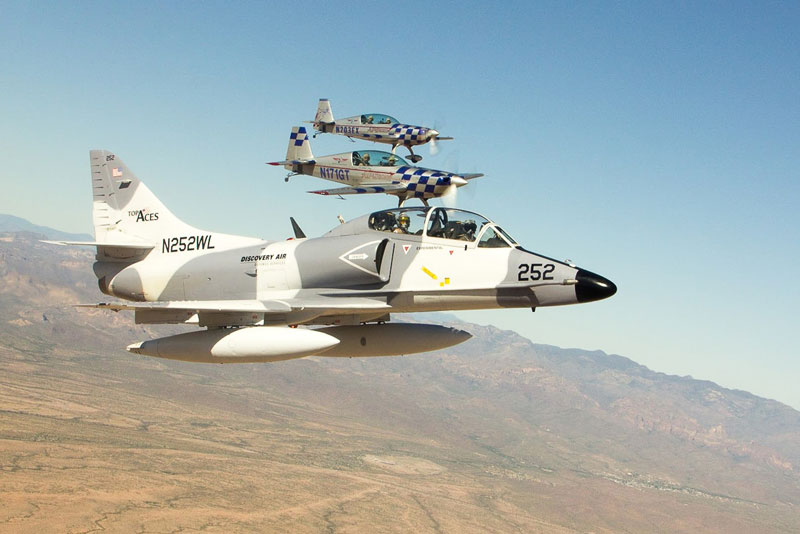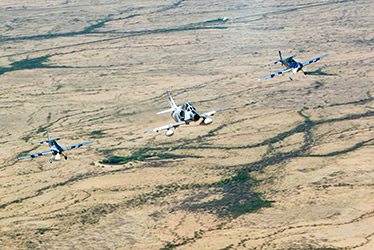 By Philip ‘OP’ Oppenheimer, Lt Col USAF (Ret) – APS A-4 Instructor and Advanced UPRT Instructor Pilot
By Philip ‘OP’ Oppenheimer, Lt Col USAF (Ret) – APS A-4 Instructor and Advanced UPRT Instructor Pilot
Today’s professional jet pilot operates at high altitude and high Mach near the edges of the envelope for most of their career. Loss of Control – Inflight (LOC-I) continues to be the number one cause of fatal aircraft accidents in commercial and general aviation. The APS A-4 Skyhawk program adds yet another layer of competency to the already-powerful APS jet upset training services, to give pilots real world jet Upset Prevention and Recovery Training (UPRT) experience when, where and how it matters most. When combined with robust academic material on pertinent aerodynamics, on-aircraft practical skill development in the Extra 300L, and APS flight simulation training devices, the transfer of upset recovery skills culminates in the A-4 Skyhawk at altitudes up to FL450 and transonic speeds up to 0.95 Mach. The knowledge, skills and disciplines embedded in this regimen of training are transferable to business jets and transport category commercial aircraft, as well as to all professional jet pilots.
The article that follows gives insight into some of the many benefits resulting from integrating the A-4 jet upset recovery training platform into a full spectrum training solution. APS provides the most comprehensive, valuable, effective, and industry-compliant upset training programs available worldwide. In the meantime, let’s discuss the A-4 high altitude jet upset training program with APS.
High Altitude Jet Upset Recovery Training
Customer feedback on the A-4 jet upset training experience has been tremendous in terms of the ‘take-away’ power and value of real-life training in an aircraft capable of all-attitude maneuvering at high altitude (see video). Even though the A-4 is capable of speeds up to 600 KIAS/Mach 1.2 and +7 and -3 Gs, the UPRT exercises are designed to stay within the customer’s representative aircraft flight envelope to include associated G limits; well within the limits of the A-4, which provides large margins of safety during training.
High altitude operations are described in Supplement #1 to the Airplane Upset Recovery Training Aid – Revision 2 (AURTA). This AURTA supplement addresses issues associated with high performance jet operations, unintentional / thrust-limited slowdowns, and upset recovery situations in the high altitude environment and specifies that training should include the ability to recognize and prevent an impending high altitude upset as well as increase the likelihood of a successful recovery from such a situation should it occur. Moreover, pilots must possess a thorough understanding of their airplane’s performance capabilities, limitations, and high altitude aerodynamics; all of which are comprehensively addressed in the APS A-4 Program in a simplified manner that gives pilots tangible, useful and accessible tools in crisis.
Transferable Skills
 The goal of all APS UPRT programs is to educate pilots so they have the knowledge and skills necessary to operate their day-to-day airplanes more safely, while substantially augmenting their ability to recognize and prevent upsets – to include high altitude stalls – and, if necessary, successfully recover from an airplane upset situation in any operational environment or flight condition. Decreasing angle of attack is still the primary objective of every stall recovery, yet the amount of time, altitude and patience required to recover from a high altitude stall is markedly different from similar low and medium altitude conditions.
The goal of all APS UPRT programs is to educate pilots so they have the knowledge and skills necessary to operate their day-to-day airplanes more safely, while substantially augmenting their ability to recognize and prevent upsets – to include high altitude stalls – and, if necessary, successfully recover from an airplane upset situation in any operational environment or flight condition. Decreasing angle of attack is still the primary objective of every stall recovery, yet the amount of time, altitude and patience required to recover from a high altitude stall is markedly different from similar low and medium altitude conditions.
To be fully prepared, APS customers develop their core upset skill sets flying in the Extra 300L with an expert UPRT instructor uniquely-qualified to teach proven-transferable concepts and skills. The Extra 300L provides a safe and cost-effective platform in which to ingrain these core skills through intensive repetition to proficiency in a wide diversity of upset conditions, where skills are then transferred to the A-4 thereby dramatically increasing the take-away value of the dedicated A-4 session. The A-4 program emphasizes a non-type-specific transfer of core UPRT skill sets to the high altitude, high Mach flight regime. The training is not specific to the A-4, meaning it addresses the aerodynamic and performance handling characteristics common to most multi-engine swept-wing jets. Unlike a simulator, the A-4 brings the “reality factor” into high altitude jet upset training. After experiencing the psychological and physiological demands of real on-aircraft upset training in the Extra 300, customers get to apply those human factor lessons to the high-altitude environment. This industry-recommended integrated training approach is instrumental in giving pilots who regularly fly in this environment comprehensive transferrable upset prevention and recovery skills applicable to almost any aircraft they may fly.
Lifetime Professional Development
 The International Federation of Airline Pilots’ Associations, Pilot Training Standards (IFALPA/IPTS) for Best Practices (2012) describes recommended best practices to develop a professional pilot. These include the initial selection process, initial training, aircraft-specific training, recurrent training and professional development. Further drill-down of these training tenants reveals the need to focus on core and basic flying skills from initial training and to continue to practice these skills throughout a pilot’s career. Along with this is the requirement for training programs to also focus on flight deck management skills. The importance of any of these skill sets and which is needed in given circumstances is situation-dependent and therefore, effective training programs must be focused on optimizing these skill sets and the interplay between them. There is a marked difference in the core and basic skill sets required to recover from an upset event (hand flying) versus the management skills required to load and fly an instrument approach using a coupled flight management system (FMS):
The International Federation of Airline Pilots’ Associations, Pilot Training Standards (IFALPA/IPTS) for Best Practices (2012) describes recommended best practices to develop a professional pilot. These include the initial selection process, initial training, aircraft-specific training, recurrent training and professional development. Further drill-down of these training tenants reveals the need to focus on core and basic flying skills from initial training and to continue to practice these skills throughout a pilot’s career. Along with this is the requirement for training programs to also focus on flight deck management skills. The importance of any of these skill sets and which is needed in given circumstances is situation-dependent and therefore, effective training programs must be focused on optimizing these skill sets and the interplay between them. There is a marked difference in the core and basic skill sets required to recover from an upset event (hand flying) versus the management skills required to load and fly an instrument approach using a coupled flight management system (FMS):
“The paradigm shift in pilot training would join these skill sets to enable the pilot to seamlessly shift between the two” with the final objective for developing a professional pilot being a “safe, sustainable lifetime of performance … pilots must be trained to depart from linear thinking and ‘think outside the box’ in order to deal with unexpected and undefined events.” IFALPA Pilot Training Standards for Best Practices 2012
This includes an unexpected aircraft upset that could result in a loss of control and applies to all aircraft, from small GA to corporate and airlines. However, the high altitude, high Mach environment presents some unique challenges:
“Most pilots are experienced in simulator or even airplane exercises that involve approach to stall. This is a dramatically different condition than a recovery from an actual stall… while flightcrews receive training on systems such as stick shakers to alert the pilots of impending stall, normally they do not receive training in actual full stall recovery, let alone stall recovery at high altitudes”. Airplane Upset Recovery Training Aid – Revision 2
The APS UPRT program addresses all aspects of stall awareness, recognition, prevention and recovery, including high altitude variations and characteristics.
Putting it all Together: The Aware and Competent Business Jet Pilot
 Our mandate at APS is to select and operate the industry’s most suitable and effective training resources to empower professional jet pilots with the tools, knowledge and skills necessary to comprehensively and effectively mitigate the LOC-I threat. There is no single solution to LOC‑I. The integration of web-based learning, classroom academics, aerobatic-capable piston & jet aircraft training platforms and advanced glass cockpit flight simulators offers a menu of overlaid services specifically developed to dramatically improve commercial air safety. The A-4 Skyhawk fills a unique, yet crucial, industry deficiency in jet upset recovery services associated with all-attitude, all-weather, high Mach and high altitude UPRT.
Our mandate at APS is to select and operate the industry’s most suitable and effective training resources to empower professional jet pilots with the tools, knowledge and skills necessary to comprehensively and effectively mitigate the LOC-I threat. There is no single solution to LOC‑I. The integration of web-based learning, classroom academics, aerobatic-capable piston & jet aircraft training platforms and advanced glass cockpit flight simulators offers a menu of overlaid services specifically developed to dramatically improve commercial air safety. The A-4 Skyhawk fills a unique, yet crucial, industry deficiency in jet upset recovery services associated with all-attitude, all-weather, high Mach and high altitude UPRT.
If you’re looking for the best, most comprehensive UPRT program in the world, we invite you to review our programs. If you choose not to use us, we recommend you get upset recovery training somewhere … ensure it is vetted by industry and in full compliance with all principles and training elements specified by the ICAO Manual on Aeroplane Upset Prevention and Recovery Training. If so, comprehensive ICAO-compliant UPRT can save your life and the lives of those who choose to fly with you.
Get the Buyer’s Guide to Effective UPRT




Comments: